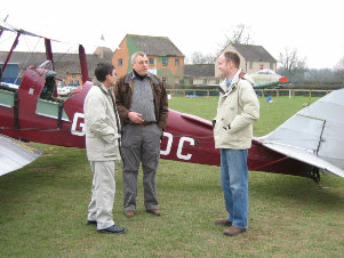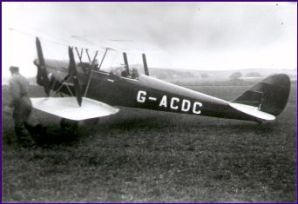Wartime Heritage
ASSOCIATION
In A Tiger Moth Over Kent, UK
On the morning of March 14th, 2006 George Egan and Glen Gaudet
travelled with WWII veteran Eric May from Maidstone, Kent, to Lashenden
Airfield (EGKH), commonly known as Headcorn, for a unique opportunity during
their trip to the UK. Eric May was a Telegraphist Air Gunner during the Second
World War, trained at No. 1 Naval Air Gunnery School at East Camp in Yarmouth
in 1944. He has been back to Yarmouth to visit the East Camp sites and has also
attended two performances of the Wartime Heritage Association's Time To
Remember stage shows. Over the past few years he has become a friend of the
Association and is an honorary board member.
Eric May was taking Egan and Gaudet to Headcorn to meet with his son,
Peter, for the chance to take a short flight in a 1933 Tiger Moth. The Tiger was
still painted in its original 1933 color scheme of maroon and silver and has
accumulated over 13000 hours of flying time throughout its long life.
This particular Tiger Moth, the G-ACDC, has a unique provenance in that it was the third DH82a Tiger Moth ever to be built
and the oldest still flying. The G-ACDC was registered February 6th, 1933; just celebrating its seventy-third birthday February
2006.
It was a cold, grey and windy morning and the weather put the flights in jeopardy (not to mention the flat tire on the way to
Headcorn which was quickly fixed by the May-Egan-Gaudet team – Fleet Air Arm air mechanics in training!). Finally the control
centre and pilot Peter May decided the weather was manageable and that take-off was "a go". Egan and Gaudet spent
approximately thirty minutes each in the Tiger Moth from take-off to landing with Peter May. They both went up separately in the
two-seater Tiger. Flying at 1000 feet, they were able to clearly make-out the Town of Maidstone and neighbouring towns and
villages, the M20 highway, the train tracks and even Leeds Castle; known as the prettiest Castle in England.
Although it is impossible to re-create the experience of war for those who have never lived it, the flights provided thrilling
insight into what it was like to fly in an open-cockpit aircraft.
The airfield itself also has an interesting history with a connection to Canada.
On the 6th August 1943 127 Wing Royal Canadian Air Force (comprising of 403 and
421 Squadrons flying Spitfire IXb's under the command of Wing Commander 'Johnny
Johnson') moved to Headcorn from RAF Kenley. The Canadians then moved on at the
end of August 1943. The airfield briefly provided a base for US Air Force units during
WWII as well.
Tiger Moth's were widely used by Allied forces both before and during WWII as
trainers. Many Tiger Moths were commonly used across Canada to train pilots under
the BCATP (British Commonwealth Air Training Plan). These biplanes made a
significant contribution in pilot training.




copyright © Wartime Heritage Association
Website hosting courtesy of Register.com - a web.com company
George Egan, Peter May and Glen Gaudet
"Tiggy" G-ACDC
In A Tiger Moth Over Kent


- World War I - Menu
- WWI Stories and Articles
- Photos - Yarmouth Soldiers
- Selection of World War I Songs
- WWI Casualties of Yarmouth, NS
- Those Who Served - Yarmouth, NS
- WWI Casualties Digby Co. NS
- WWI Casualties Shelburne Co. NS
- Merchant Mariners (1915) Yarmouth, NS
- Canadian Forestry Corps - Non Yarmouth Birth/Residence Enlistments
- US Draft Registry - Yarmouth NS Born


- World War II - Menu
- WWII Stories and Articles
- Telegraphist Air Gunners
- WWII Casualties of Nova Scotia
- US Casualties with NS Connection
- Far East/Pacific Casualties with NS Connection
- Merchant Navy Casualties Nova Scotia
- Nova Scotia WWII Casualties Holten Canadian War Cemetery
- D-Day Casualties - Nova Scotia
- CANLOAN Program Casualties - Nova Scotia
- Battle of the Bulge Casualties - Nova Scotia
- WWII Casualties Yarmouth NS
- Yarmouth Casualties - RCAF RAF Canadian Army WWII
- Yarmouth Co., Marrages WWII
- Casualties Non-Born/Residents with Connection to Yarmouth Co., Nova Scotia.
- WWII Casualties Digby Co., NS
- Non-Nova Scotian WWII Casualties Buried in Nova Scotia
- WWII RCAF Casualties Aged 16-18
- Brothers/Sisters Who Served - World War II













